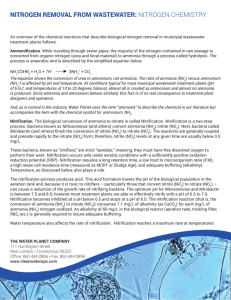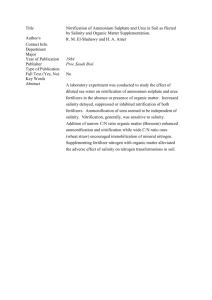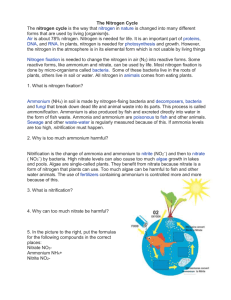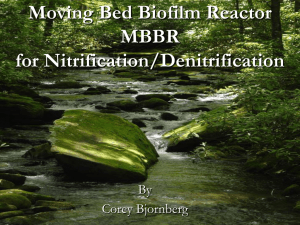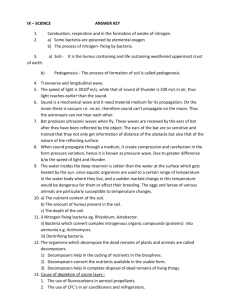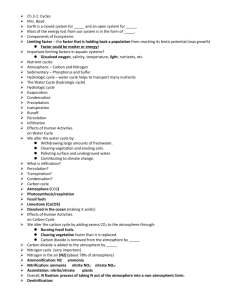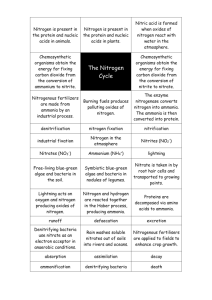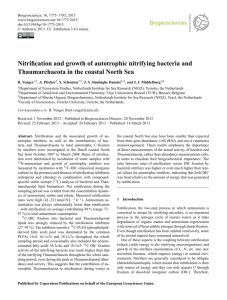Nitrification & Denitrification
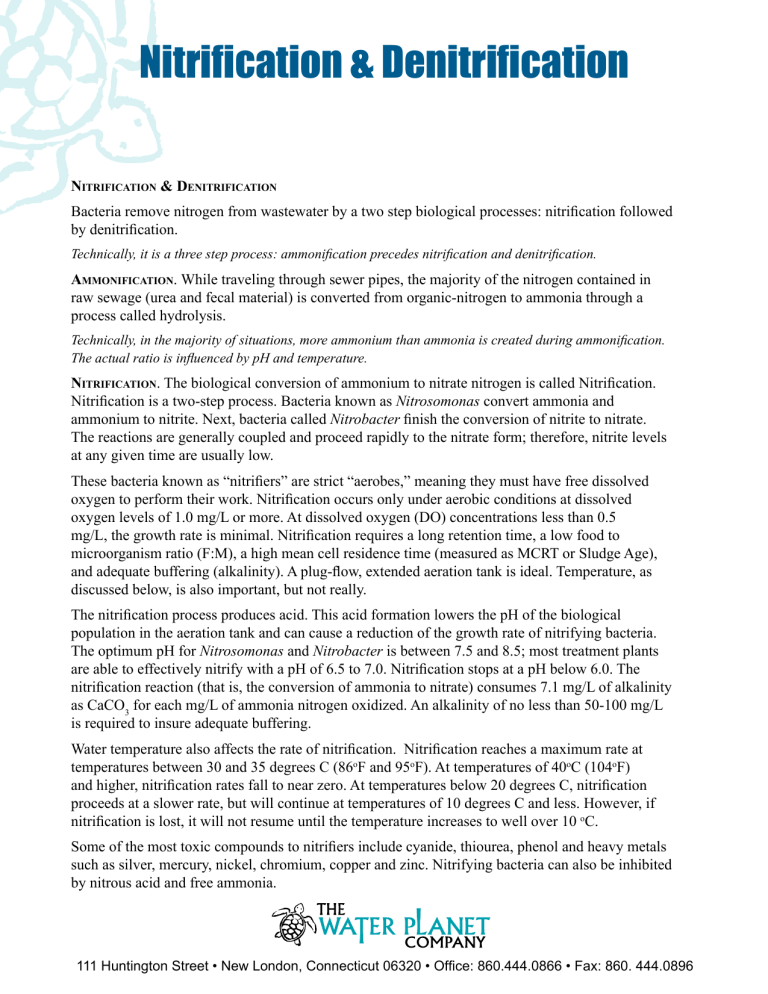
Nitrification & Denitrification
N itrificatioN
& D eNitrificatioN
Bacteria remove nitrogen from wastewater by a two step biological processes: nitrification followed by denitrification.
Technically, it is a three step process: ammonification precedes nitrification and denitrification.
a mmoNificatioN
. While traveling through sewer pipes, the majority of the nitrogen contained in raw sewage (urea and fecal material) is converted from organic-nitrogen to ammonia through a process called hydrolysis.
Technically, in the majority of situations, more ammonium than ammonia is created during ammonification.
The actual ratio is influenced by pH and temperature.
N itrificatioN
. The biological conversion of ammonium to nitrate nitrogen is called Nitrification.
Nitrification is a two-step process. Bacteria known as Nitrosomonas convert ammonia and ammonium to nitrite. Next, bacteria called Nitrobacter finish the conversion of nitrite to nitrate.
The reactions are generally coupled and proceed rapidly to the nitrate form; therefore, nitrite levels at any given time are usually low.
These bacteria known as “nitrifiers” are strict “aerobes,” meaning they must have free dissolved oxygen to perform their work. Nitrification occurs only under aerobic conditions at dissolved oxygen levels of 1.0 mg/L or more. At dissolved oxygen (DO) concentrations less than 0.5 mg/L, the growth rate is minimal. Nitrification requires a long retention time, a low food to microorganism ratio (F:M), a high mean cell residence time (measured as MCRT or Sludge Age), and adequate buffering (alkalinity). A plug-flow, extended aeration tank is ideal. Temperature, as discussed below, is also important, but not really.
The nitrification process produces acid. This acid formation lowers the pH of the biological population in the aeration tank and can cause a reduction of the growth rate of nitrifying bacteria.
The optimum pH for Nitrosomonas and Nitrobacter is between 7.5 and 8.5; most treatment plants are able to effectively nitrify with a pH of 6.5 to 7.0. Nitrification stops at a pH below 6.0. The nitrification reaction (that is, the conversion of ammonia to nitrate) consumes 7.1 mg/L of alkalinity as CaCO
3
for each mg/L of ammonia nitrogen oxidized. An alkalinity of no less than 50-100 mg/L is required to insure adequate buffering.
Water temperature also affects the rate of nitrification. Nitrification reaches a maximum rate at temperatures between 30 and 35 degrees C (86 o F and 95 o F). At temperatures of 40 o C (104 o F) and higher, nitrification rates fall to near zero. At temperatures below 20 degrees C, nitrification proceeds at a slower rate, but will continue at temperatures of 10 degrees C and less. However, if nitrification is lost, it will not resume until the temperature increases to well over 10 o C.
Some of the most toxic compounds to nitrifiers include cyanide, thiourea, phenol and heavy metals such as silver, mercury, nickel, chromium, copper and zinc. Nitrifying bacteria can also be inhibited by nitrous acid and free ammonia.
111 Huntington Street • New London, Connecticut 06320 • Office: 860.444.0866 • Fax: 860. 444.0896
Continued - Nitrification & Denitrification
The following equations describe the nitrification process.
Alkalinity buffering equation
H
2
0 + CO
2
H
2
CO
3
HCO
3
+ H + CO
3
+ 2H+
Nitrification equations
NH
NO
4
+
2
-
+ 1.5O
2
+ 0.5O
2
2H + + 2H
2
O + NO
2
-
NO
3
-
NH
4
+ + 1.83 O
2
+ 1.98 HCO3 -
NH
4
+ + 1.9O
2
+ 2HCO3 -
0.021 C
5
H
7
0
2
N + 0.98 NO
3
+ 1.041 H
2
O + 1.88 H
2
CO
3
-
1.9 CO
2
+ 2.9 H
2
O + 0.1 CH
2
From the above equations, it can be calculated that for every pound of ammonia oxidized to nitrate, the following occurs:
4.18 pounds of oxygen are consumed
7.14 pounds of alkalinity as calcium carbonate (as
CaCO
3
) is consumed
12 pounds of alkalinity as sodium bicarbonate
(NaHCO
3
) is consumed
D eNitrificatioN
. The biological reduction of nitrate (NO
3
) to nitrogen gas (N
2
) by facultative heterotrophic bacteria is called Denitrification. “Heterotrophic” bacteria need a carbon source as food to live. “Facultative” bacteria can get their oxygen by taking dissolved oxygen out of the water or by taking it off of nitrate molecules.
Denitrification occurs when oxygen levels are depleted and nitrate becomes the primary oxygen source for microorganisms. The process is performed under anoxic conditions, when the dissolved oxygen concentration is less than 0.5 mg/L, ideally less than 0.2. When bacteria break apart nitrate
(NO
3
gas (N
) to gain the oxygen (O
2
2
), the nitrate is reduced to nitrous oxide (N
2
O), and, in turn, nitrogen
). Since nitrogen gas has low water solubility, it escapes into the atmosphere as gas bubbles.
Free nitrogen is the major component of air, thus its release does not cause any environmental concern.
The formula describing the nitrification reaction follows:
6NO
3
- + 5CH
3
OH 3N
2
+ 5CO
2
+ 7H
2
O + 6OH’
A carbon source (shown in the above equation as CH
3
OH) is required for denitrification to occur.
111 Huntington Street • New London, Connecticut 06320 • Office: 860.444.0866 • Fax: 860. 444.0896
Continued - Nitrification & Denitrification
Optimum pH values for denitrification are between 7.0 and 8.5. Denitrification is an alkalinity producing process. Approximately 3.0 to 3.6 pounds of alkalinity (as CaCO liquor.
3
) is produced per pound of nitrate, thus partially mitigating the lowering of pH caused by nitrification in the mixed
Since denitrifying bacteria are facultative organisms, they can use either dissolved oxygen or nitrate as an oxygen source for metabolism and oxidation of organic matter. If dissolved oxygen and nitrate are present, bacteria will use the dissolved oxygen first. That is, the bacteria will not lower the nitrate concentration. Denitrification occurs only under anaerobic or anoxic conditions.
Another important aspect of denitrification is the requirement for carbon; that is, the presence of sufficient organic matter to drive the denitrification reaction. Organic matter may be in the form of raw wastewater, or supplemental carbon. Conditions that affect the efficiency of denitrification include nitrate concentration, anoxic conditions, presence of organic matter, pH, temperature, alkalinity and the effects of trace metals. Denitrifying organisms are generally less sensitive to toxic chemicals than nitrifiers, and recover from toxic shock loads quicker than nitrifiers.
Temperature affects the growth rate of denitrifying organisms, with greater growth rate at higher temperatures. Denitrification can occur between 5 and 30 o C (41 o F to 86 o F), and these rates increase with temperature and type of organic source present. The highest growth rate can be found when using methanol or acetic acid. A slightly lower rate using raw wastewater will occur, and the lowest growth rates are found when relying on endogenous carbon sources at low water temperatures.
Wastewater cannot be denitrified unless it is first nitrified.
N itrogeN
f orms
Nitrogen exists in several forms. The principal nitrogen types of concern to wastewater treatment are: Total Nitrogen, Total Kejeldahl Nitrogen (TKN), Ammonia, Organic Nitrogen, Nitrate and
Nitrite. Concentrations are reported in mg/L, as Nitrogen.
The relationships of the various forms is confusing, but important to understand. total-Nitrogen (total-N). In order to determine the total-Nitrogen concentration, laboratory testing of TKN, Nitrate and Nitrite is required. The results of the three tests are added together.
Technically, if regulations allow, total-N may be determined by performing only two lab tests: TKN and nitrite+nitrate.
Total-N = TKN + NO
3
+ NO
2
111 Huntington Street • New London, Connecticut 06320 • Office: 860.444.0866 • Fax: 860. 444.0896
Continued - Nitrification & Denitrification
Total Kejeldahl Nitrogen (TKN). TKN includes Ammonia and organic-Nitrogen. A municipal wastewater treatment plant with an effluent containing more than 5 mg/L TKN is not fully nitrifying.
TKN = NH
3
+ org-N
Ammonia nitrogen is ammonium (NH
(NH
NH
3
3
(NH
3
or NH
4
). When the pH of the wastewater is acidic or neutral, the majority of the
is not fully nitrifying.
4
+ ). When the pH increases over 8.0, the nitrogen is mostly ammonia
). A municipal wastewater treatment plant with an effluent containing more than 2 or 3 mg/L organic-Nitrogen (org-N). A small fraction, typically one or two milligrams per liter, of the organic-Nitrogen is not amenable to biological treatment and passes through the treatment facility untreated as organic-Nitrogen. Quaternary ammonia (a form of organic-Nitrogen) is used as a bactericide by food handling businesses. At low concentrations, “quats” can be toxic to wastewater bacteria. Quaternary ammonia passes through treatment plants unchanged. A municipal wastewater treatment plant that is effectively nitrifying generally contains less than 3 mg/L organic-Nitrogen.
Nitrate (NO
3
). Without additional information, the NO of little value. An effluent NO
3
3 fully nitrified and denitrified as well as in effluent with no nitrogen removal at all. An effluent that is fully nitrified but has not been denitrified will generally contain an NO approximately 20 mg/L.
concentration in municipal effluent is
concentration of less than 3 mg/L exists in wastewaters that are
3
concentration of
Nitrite (NO
2
). Municipal wastewater effluents generally contain less than 1 mg/L NO
2
. Greater concentrations are generally found when a facility is partially nitrifying.
Nitrogen Gas (N
2
). The air we breathe is 78% N
2
and only 21% oxygen. The remaining one percent is argon and other inert material.
111 Huntington Street • New London, Connecticut 06320 • Office: 860.444.0866 • Fax: 860. 444.0896

